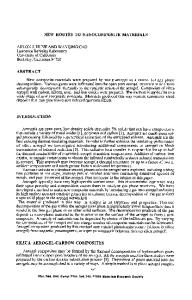Metallic Bonding, Dislocations, and Disclinations: Routes to Materials Science
- PDF / 1,893,482 Bytes
- 3 Pages / 604.8 x 806.4 pts Page_size
- 1 Downloads / 433 Views
Prof. Jacques Friedel Solid State Physics Laboratory University of Paris the grain boundary tension varies with the relative misorientation of the two grains, having checked that the tension does not vary much with the orientation of the boundary with respect to the crystals, a remark that justifies the method. This was one of the first measurements of this kind, and I was quite happy with it until I tried to express
these tensions in terms of interatomic forces in the metal. I searched the literature for these forces. But all I could find in Mott and Jones' and Seitz' books was on the cohesion of perfect crystals and, for metals, on alkalis. It was then in a state of frustration that I gladly accepted my cousin's suggestion to go and learn about the electronic structure of metals with his friend Nevill Mott in Bristol. In Bristol, N.F. Mott asked me to study the electronic structure of an impurity atom in a metal: how would the essentially free valence electrons of the metal be scattered by the impurity in a "self consistent" way that would screen its excess nuclear charge? I solved this problem numerically with the help of a slide rule, and observed, then proved mathematically, that the total screening charge was related to the asymptotic behavior of the electrons of highest energy, the "Fermi" electrons. Furthermore, this screening wasn't completely localized on the impurity atom: it had long-range oscillation with decreasing amplitude and a wavelength equal to half the Fermi wavelength XP As a result, two impurities will feel each other at distance. More precisely, in a monovalent metal such as copper, with a fairly large \& two impurities repel at short range because they are not completely screened to each other at nearest-neighbor distance; this shortrange order hardens the metal, as any prehistoric man of the bronze age knew, of course! In polyvalent metals such as aluminum, with shorter A& impurities attract at nearest-neighbor distance because they are overscreened to each other: hence the stability of the Guinier Preston zones which harden alloys such as duralumin, used, for instance, in the building of Concorde planes. This field of impurities in metals led to many experimental and theoretical works, where many people contributed. And it was only when it was well understood that, with my ex-PhD student Andr6 Blandin, we asked ourselves whether this new knowledge could not help us to understand the cohesion of pure metals. Indeed, for the sp metals such as copper or aluminum the valence electrons are not perfectly free; they are weakly scattered by the atoms. As A. Blandin and R. Pick showed, the cohesive energy can then be developed in successive powers of the atomic scattering; and the first structure-sensitive terms in this development are obviously of second order, when valence electrons are scattered successively by two atoms, as if these
53
Metallic Bonding, Dislocations, and Disclinations: Routes to Materials Science
Other remarks can be made on this example. First, the model I have just sketc
Data Loading...











